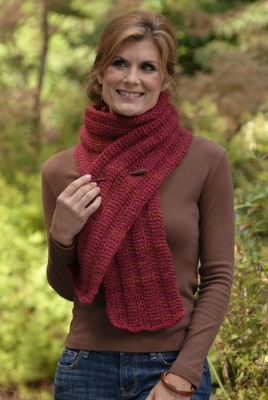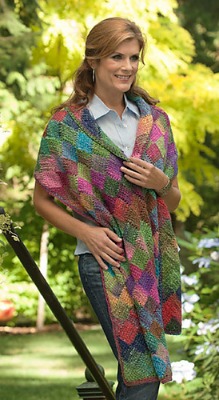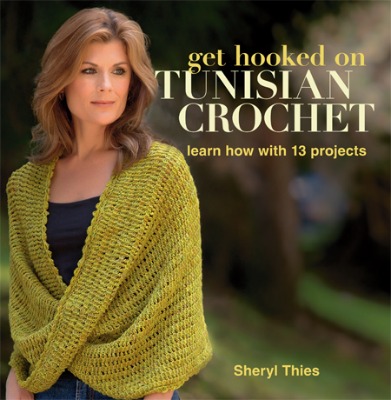This post contains affiliate links.
My regular readers know that I’m a lover of Tunisian crochet. I recently finished reading an ebook copy of Get Hooked on Tunisian Crochet: Learn How with 13 Projects by Sheryl Thies from Martingale, and I’m sharing the review today. (Sheryl’s second Tunisian crochet book with Martingale, Tunisian Crochet Encore
, was published this spring.)
In Get Hooked on Tunisian Crochet, Sheryl Thies takes an interesting approach to the craft. The other beginner Tunisian crochet books I’ve recently read (Kim Guzman‘s Ultimate Beginner’s Guide to Tunisian Crochet
, reviewed here, and Dora Ohrenstein‘s The New Tunisian Crochet
, reviewed here) are written by (primarily) crochet designers. When Sheryl wrote the book, she was primarily a knitting designer and it’s interesting to see how that lens impacted her writing.
Get Hooked opens with a brief history of the craft (which, like most crochet histories, has gaps) and then moves onto an overview of different hooks. Then there is a written and illustrated tutorial of Tunisian crochet basics. As someone who learns best through reading, I found Sheryl’s detailed explanations of each stitch very helpful. My regular readers know that I personally find line illustrations useless for learning crochet techniques – my brain just doesn’t work that way. I can imagine that the lack of photo tutorials might make this book challenging for a true newbie who learns best through images.
Sheryl includes a troubleshooting chart right in this section, with causes and fixes to common beginner Tunisian crochet issues, and I applaud her for not burying that critical information in the appendices. Similarly, Sheryl includes information on increasing and decreasing and color changes right up front, rather than hiding it in the appendices. This formatting decision makes the book very beginner friendly, as you can see immediately what instructions are available to you while reading through the book.
Sheryl then dedicates a few pages to a discussion of gauge and blocking. I think her background as a knitting designer influenced her to emphasize blocking, which is generally discussed minimally in crochet books. For Tunisian crochet, which tends to curl, blocking can truly transform a project so it is great to see it discussed right up front. (Actually blocking instructions are in an appendix, however.)

The book then dives into the patterns. I count 17, while the book subtitle lists 13. There are a few patterns with multiple components (i.e., a pullover with matching handwarmers) that could be completed separately, which accounts for the difference.
Pattern difficulty:
- 1 beginner pattern,
- 10 easy patterns, and
- 6 intermediate patterns.
Project types:
- 8 home decor projects, including 3 pillow covers, 2 bags, a blanket, placemats, and coasters,
- 6 accessories projects, including 4 shawls/wraps, a scarf, and a pair of handwarmers, and
- 3 women’s garments, including a cardigan, pullover, and jacket.

All of the home decor patterns use medium weight yarns, and the accessories and garment designs feature several weights (mostly lighter than medium weight). There is a diverse mix of yarns including some large brands and smaller, independent companies. Again, I think Sheryl’s background as a knitting designer made her (and her publisher, and the yarn companies) more open to including lighter weight yarns.
My favorite patterns are the Button Down pillow cover, the Motivated Heretic entrelac shawl, and the Rogue Ribs scarf. While Sheryl includes a range of pattern difficulty levels, the projects are beginner friendly. Most have minimal shaping, and for the entrelac project, she uses one, multi-color yarn rather than have beginners using many different skeins. Even the garments use simple construction techniques.
The book ends with appendices which discuss finishing (seaming, blocking, and adding “regular” crochet edges); charts for yarn and hook sizes, metric conversions, and pattern skill levels; and a list of materials resources.

Like many books which include techniques and patterns, your enjoyment of the book will be improved if you like the patterns and are enthusiastic about learning the techniques by crocheting them. (Ravelry members can see all of the patterns from the book here.) While the book does include technical information about Tunisian crochet which would be helpful to a newbie, it may not be enough to let the book stand alone if you don’t find some patterns that you enjoy. I recommend this book to new Tunisian crocheters, particularly those who enjoy working with lighter weight yarns, who enjoy learning the background details (the “whys”) of different techniques, and who learn from reading rather than primarily visually. If you are an experienced Tunisian crocheter, you should take a look through the patterns to decide whether this book may be right for your style.

